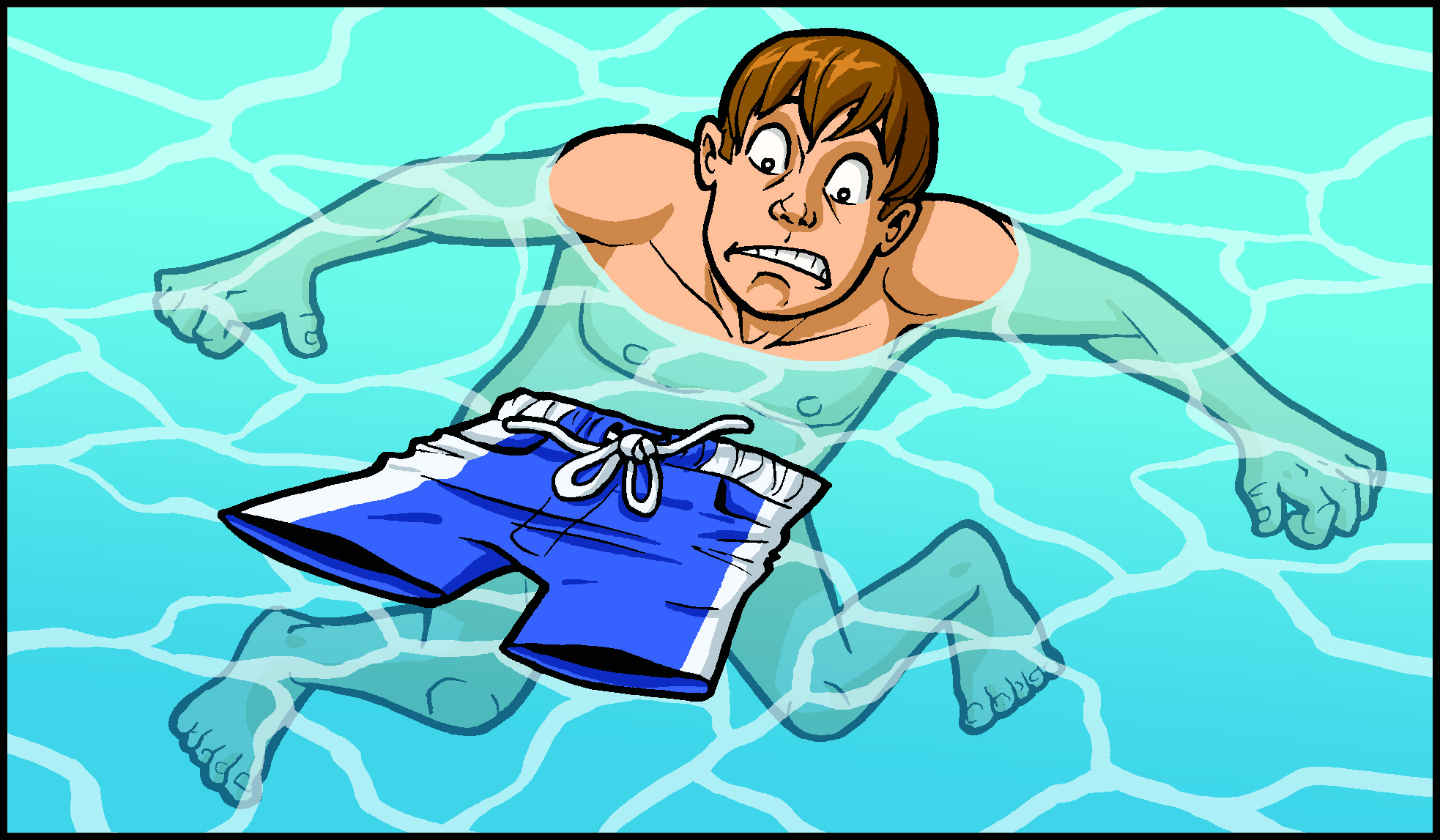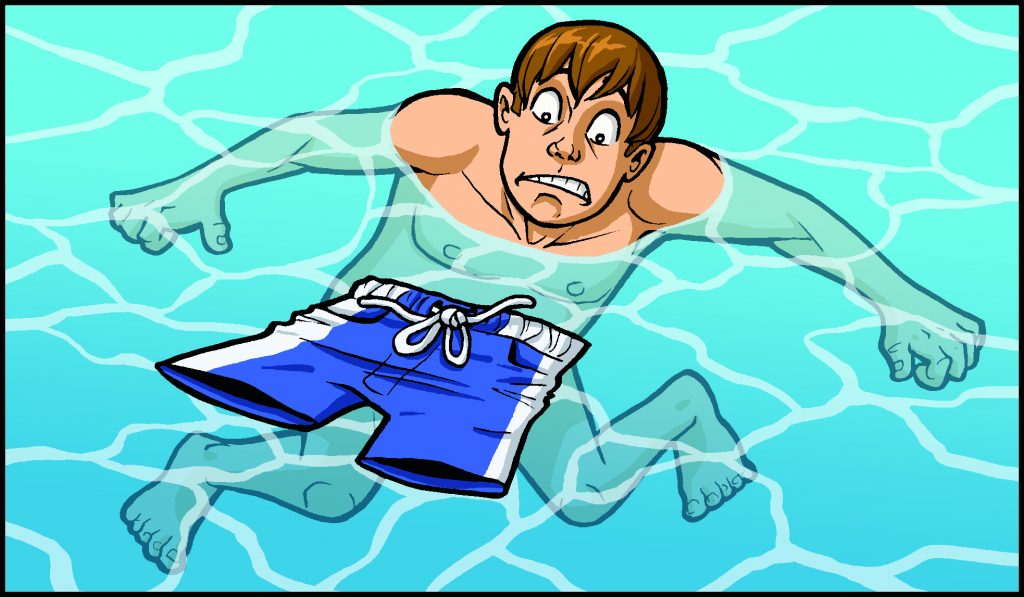The Bathing Suit
By Matthew Dicks / Illustrated By Sean Wang
When I was about 12 years old, I attended an end-of-school-year pool party at a classmate’s home. I was thrilled to be invited. The classmate was a girl, which meant she didn’t find me repulsive – which was not always guaranteed at the time. Her family owned an in-ground swimming pool and diving board, which, in addition to cupcakes and lemonade, made for a promising afternoon.
Shortly after arriving, I mounted the diving board for my first plunge into the pool. The Spotlight Effect – the mistaken belief that people are paying more attention to you than they really are – was in full effect that day. As I prepared to dive, I was quite certain that the eye of every classmate was upon me.
According to the Spotlight Effect, it was probable that no one was paying any attention to me, and rightfully so.
I took three long, purposeful strides, landing both feet perfectly on the edge of the board, then I bounced, launching myself high into the air. At the apex of my ascent, I jackknifed, pointing my head and arms to the water, and executed the perfect dive.
Everything went swimmingly – see what I did there? – until I hit the water and realized that I had failed to secure the waistband of my already too large swimming trunks by forgetting to tie the drawstring into a bow.
As a result, my body surged into the water, but I left my bathing suit behind. Rather than a bathing suit, I found myself under water at a classmate’s pool party in my birthday suit.
My first reaction was to panic, but my next was an immediate, purposeful, necessary rejection of the Spotlight Effect. “No one is watching,” I thought. “Just find your bathing suit and slide it on while remaining underwater. No one will notice.”
I looked up and spotted it:
A floating, blue and white pair of swim trunks near the surface of the water. I kicked up, grabbed the trunks, but by now, I was nearly out of air, in desperate need of a breath. I pulled the swim trunks down to conceal myself as best as I could and came to the surface for a quick breath. As my head broke the surface, I saw them. My classmates. Many of them.
Most of them. Staring at me, naked in the pool. Laughing.
The Spotlight Effect apparently did not apply that day. Or perhaps it was simply the pair of swim trunks floating near the surface of the water, absent of any owner, that had attracted their attention.
Happily, I managed to overcome that humiliating moment in my life. It took about a quarter of a century, but eventually, the embarrassment wore off, but it left me with a deep and profound amusement in the way that human beings dress for the water.
For the entire school year, my classmates had seen me walking the halls of the school in a shirt, pants, belt, socks, and shoes. As the weather warmed, I’d shifted from pants to shorts, but still, most of my body was covered by at least one layer, and my nether regions were always covered by at least two.
Then one day, because a swimming pool was involved, I was reduced to a single item of clothing, just large enough to cover my unmentionables, that required a drawstring to keep affixed to my body.
I was essentially in my boxer shorts in front of my classmates.
My underwear.
It was an accident waiting to happen.
The whole situation involving attire is bizarre when it comes to swimming. We spend our days, covering most of our bodies from neck to toes from the rest of the world, concealing all but the occasional leg (if we’re wearing shorts or skirts or kilts or dresses) and shoulder. We typically cover up most private parts with two layers, and sometimes more. We are buttoned up and safe from any possible accidents.
A few years ago, I was standing in front of my class, teaching, when I removed the sweatshirt that I was wearing. A second later, a student in the front row said, “Mr. Dicks, I can see your underwear.” I thought the student was referring to the waistband of my underwear, poking up from the waistband of my pants, but no.
There was an enormous hole in the front of my pants.
We owned a cat at the time named Owen who ate wool like I eat cheeseburgers. He had been sitting in my lap earlier that morning before school, apparently eating his way through my pants without me noticing. Before leaving the house, I had tossed on a sweatshirt that extended below the hole, so until I removed it, the hole was concealed.
My point:
Even when an animal chews off the front of your pants, you don’t end up naked in real life because of the layers of clothing typically worn.
But on the beach or the pool?
One loose drawstring, one poorly tied knot on a bikini strap, or one especially large wave, and suddenly you’re naked in front of friends and family.
When it comes time to swim in a pool or lake or ocean, we essentially strip down to our underwear and spend time with friends, family, colleagues, clients, and strangers. We swim alongside them. Eat cheeseburgers together while nearly naked. Play volleyball or frisbee, diving through the air in undergarments in an attempt to keep a ball aloft or snatch a disc from midflight.
This is not an exaggeration. I have worked, for example, with female colleagues in professional situations for the entire year, only to find myself on the beach with that same person three weeks later in a bikini, which amounts to little more than a colorful bra and panties.
One day, we’re seated around a conference table in business attire, discussing serious matters, but the next, because we might (or might not) be entering the water, we’ve arrived at a public location in our underwear, yet it’s completely normal.
Don’t get me wrong. It’s not like it doesn’t make at least some sense. No one wants to swim in jeans and a pullover. Cashmere and saltwater don’t exactly mix. Shakespeare’s Ophelia dies by suicide after leaping into a river in a dress.
We shouldn’t swim in the same clothing that we wear to the office or the laundromat or the pool hall, but still, it’s weird.
The differences between male and female swimsuits seem odd, too. Today, I wear a bathing suit that stretches halfway to my knees, and it’s designed so that even if the drawstring comes untied, it’s not going anywhere. But it’s also loose fitting, like shorts. In fact, I could wear my bathing suit as shorts and no one would really notice.
And yes, some men wear Speedos, often as a part of swim training and competitions, but some wear Speedos recreationally, too. But those gents are few and far between.
I also suspect that those recreational wearers of Speedos are also donning them for competitive purposes, too.
Just a different kind of competition.
I’ve also started wearing a swim shirt – a loose-fitting, moisture-wicking tee shirt designed to feel soft against the skin, allow for unimpeded swimming, and best of all, protect against the sun.
When I’m wearing my bathing suit and swim shirt, I look like I’m wearing shorts and a tee shirt. The fabric is different, of course, but to the outside observer, I essentially swim in the same clothing that I wear all summer.
But women? While some wear trunks and tee-shirt-styled swim shirts, the majority of female swim suits are form fitting and cover far less of the body than a man’s bathing suit. Even as a one-piece, the female swimsuit leaves little to the imagination.
Why do men swim in the same kind of clothing they might wear to a park or parade, but women wear swimsuits that hug their bodies and expose far more skin to the world (and the sun)? According to sunscreen manufacturers, male swimsuits (just the trunks cover 10-20% of a man’s body), while bikinis cover just 3- 9%.
That’s before I even don my swim shirt.
It all makes for a bizarre yet socially accepted form of socialization while in our underwear.
I think I know why.
When I was a teenager, my friends and I went to Moonstone Beach in South Kingston, Rhode Island. At the time, Moonstone was a nude beach, so my friends and I were looking forward to our first encounter with public nudity. I was admittedly worried that I might not find the courage to remove all of my clothing once we arrived, but that concern evaporated quickly.
One look at the people walking the beach made it clear that even though our bathing suits amount to little more than publicly acceptable underwear, that underwear can make a big difference in terms of concealing parts that are best kept concealed. To my 16-year-old eyes, the minuscule coverage that bathing suits afford was more important than I had ever imagined.
No wonder my classmates were laughing at me that day.
Matthew Dicks is an elementary school teacher, bestselling novelist, and a record 55-time Moth Story SLAM champion. His latest books are Twenty-one Truths About Love and The Other Mother.
Sean Wang, an MIT architecture graduate, is author of the sci-fi graphic novel series, Runners. Learn more at seanwang.com.








More Stories
Sink or Swim
Spring Cleaning: Who is Really Doing the Cleaning?
What Has Happened to Our Children: Part 2